I first started covering EOH Holdings in the early days of my career when I was an analyst at a large blue bank. I recall calling up the founder and then-CEO, Asher Bohbot, having a meeting to discuss the business, and asking for the latest results presentation.
He looked surprised, as they had “never done one those things before”. The next year, there was a results presentation, but I think I could count the number of attendees on one hand.
ADVERTISEMENT
CONTINUE READING BELOW
Read:
Yet in those days, EOH was growing revenue and headline earnings per share (Heps) at 20-30% year on year and had the cash flows to back it. Its market cap was a fraction of a billion rand and its stock was tightly held and cheap. It was a great business and a great investment.
Fast-forward about a decade and a bit, and the only things that had swollen larger than EOH’s results presentations attendance was the goodwill on its group balance sheet, its stock’s valuation, and management’s acquisitive appetite.
But then EOH’s share price rally started to stall, then a scandal or three broke out, earnings grew tepid, cash flows vanished, investor selling pressure drove down its share’s valuation and, with the group unable to buy growth, the whole thing came undone.
Share price dive
Then in strode a knight in shining armour: Stephen van Coller.
And suddenly there was a clamour for investing behind the turnaround!
Worth a second look?
My answer was and remains: No, you should (almost) never invest in a service firm’s turnaround.
Service businesses’ largest asset flows through their income statement as an expense: salaries for employees.
It is off these skills, knowledge and relationships that a service business generates value and bills clients.
An anomaly of this type of business model is that your largest asset can walk out the door at any moment. This is less of a risk in a low-skilled workforce where skills are less concentrated on the payroll (think blue-collar service firms like pest control, call centres and security) – but it is a major risk in high-skilled workforces where millions can be bid for top employees.
So why does this make a white-collar service firm turnaround difficult to invest in?
Well, the white-collar service firm’s most valuable employees with the highest, most marketable skills are also the most mobile of their employees. And they tend not to want to be on a sinking ship and/or associated with a troubled business. Their own careers have reputational risk!
Thus, the moment there is even the smallest whiff of problems, these employees tend to flood out of a business (into its competitors’ open arms, no doubt). Clients and potential clients see this and/or hear rumours and grow nervous about contracting the firm’s services …
ADVERTISEMENT
CONTINUE READING BELOW
Double whammy
This is the double whammy of a service firm turnaround: your top talent floods out (making your services less competitive) simultaneous to your clients growing nervous about doing business with you (stalling or shrinking your sales).
In a simplistic way, a white-collar service firm is little more than a confidence game.
When that confidence is lost by employees and clients, the business is pretty much over.
Despite Van Coller’s sterling and commendable efforts at EOH, the above is basically what has been happening there.
Read:
Former EOH finance chief John King dies amid R1.7bn damages claim [Oct 2021]
Anonymous group claims ‘crisis’ at EOH was manufactured [Nov 2021]
Zondo praises EOH for coming clean, but says it cannot keep the proceeds of corruption [Apr 2022]
Its latest trading statement points to declining revenues (down 2-4% year on year), and I have less confidence in the ultimate success of this turnaround with each reporting period.
Source: Various EOH reports, and annualising its latest H1:24 trading update for the full-year.
There may be exceptions (and I did hope EOH was one) but this is why I do not invest in service firm turnarounds. When the confidence is gone, the business is gone.
Read: EOH’s Stephen van Coller exits after five years [Oct 2023]
Keith McLachlan is chief investment officer at Integral Asset Management.

